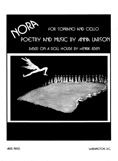Nora
for soprano and cello
[based on A Doll's House by Henrik Ibsen]
Arsis Press, 23 minutes
"Larson's Nora is a satisfying, and extended retelling of Ibsen's A Doll's House through the character of the loyal but misused wife. Larson aims at a direct dramatic retelling, no fuss or fanciness, and it works. It also leaves one wishing that, despite the interest of the cello line (and the very fine performance by cellist Lori Barnet), the work might be expanded for a larger ensemble."" (The Washington Post)
 |
Nora was premiered on March 1, 2001 by Pamela Jordan Schiffer, soprano, and Lori Barnet, cello, in a concert of The Contemporary Music Forum at the Corcoran Gallery of Art in Washington, D.C. The six sections of the piece are titled: Prologue, Torvald, Tarantella, The Letter, Departure, and Epilogue.
The composer writes: "I have chosen to write this dramatic chamber work from inside Nora's mind and memory, as she ponders and relives her experience with [her husband] Torvald. When she finally leaves him, she is completely clear on the need to escape his influence, but she steps into the unknown. After all the flirting and manipulating, all the fear and panic, a powerful calm comes over her as she sees what she must do. Her statement to Torvald is decisive and fueled by many emotions, but she is not as confidently judgmental as a 20th or 21st century woman might be. Despite Torvald's behavior, which seems monstrous to us now, I feel he too is a victim of society. My viewpoint is personal in that I have seen the damage done to my Norwegian foremothers, and I have lived with currents of this in my own internal life. But the message is universal, relevant to every human being: learning to think and act on one's own requires a lifetime of introspection and courage."
"Reducing this exquisitely balanced play to a 20-minute song cycle necessarily means neglecting important and wonderful characters. It pains me, for example, to leave out Nora's destitute but proud friend, Christina Linde. With her well-earned disillusionment, she is the perfect foil for Nora, and it is her relationship with Krogstad that ultimately moves him to soften and to retract his threat. Dr. Rank, the family friend, loves Nora and hides his impending death from Torvald because Torvald does not like ugly things. Despite Nora's flightiness around Dr. Rank, she is the one in whom he felt he could confide. It is, however, the distillation of Nora's story with respect to Torvald that I sought, which accounts for the focused voice and cello instrumentation."
"Nora is divided into six parts, including a prologue and epilogue of my own poetry and imagery. The middle four sections have been condensed from several translations and shaped into verse that shows Nora's experiences alternately relived and pondered by her. The piece is built almost exclusively on octatonic scales [alternating whole and half steps], both melodically and harmonically, occasionally stretching to diatonic (or even whole-tone) or constricting to chromatic, as the moment requires."
Dedication: "Nora is dedicated to my brilliant and wonderful mother, Florence Faye Newcomb Larson. In the 1930's, as a graduate student at the Royal Academy of Dramatic Art in London, she played the part of Nora and later went on to a modest career in acting, teaching and directing. I am indebted to her for having developed in me a feel for theatre at its finest."